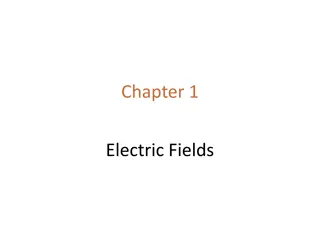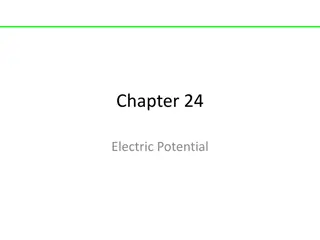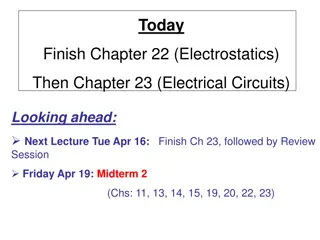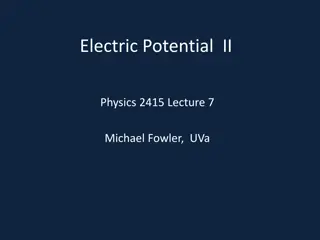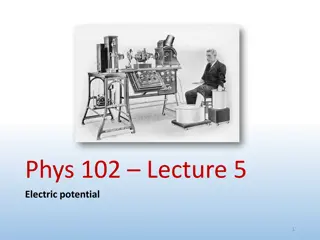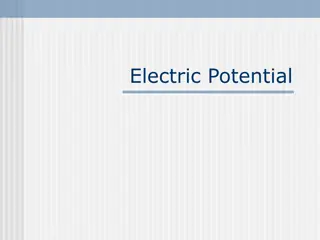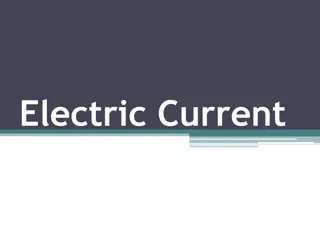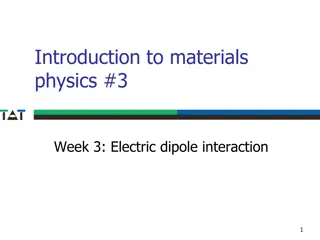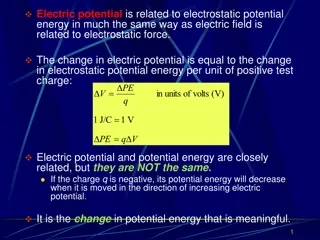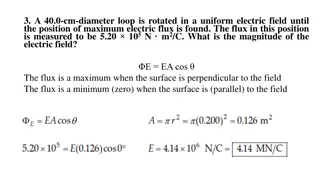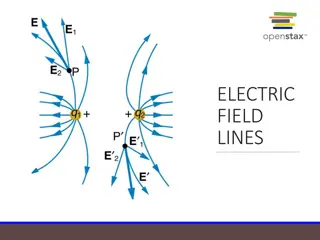
Understanding Electric Potential Energy and Voltage Concepts
Explore the concepts of electric potential energy, electric energy, electric potential, voltage, and more. Learn about the relationship between charge, energy, and fields in both attraction and repulsion scenarios. Discover how batteries maintain potential differences and drive the flow of current. Visit the provided links for further insights.
Download Presentation

Please find below an Image/Link to download the presentation.
The content on the website is provided AS IS for your information and personal use only. It may not be sold, licensed, or shared on other websites without obtaining consent from the author. If you encounter any issues during the download, it is possible that the publisher has removed the file from their server.
You are allowed to download the files provided on this website for personal or commercial use, subject to the condition that they are used lawfully. All files are the property of their respective owners.
The content on the website is provided AS IS for your information and personal use only. It may not be sold, licensed, or shared on other websites without obtaining consent from the author.
E N D
Presentation Transcript
ELECTRIC ENERGY Since the fields are similar between gravitational and electric energy; both are inversed squared force fields This represents the amount of energy to bring the charge to a radius of infinity (if repulsion) or 0 (if attraction) We can use a similar relationship for energy: ??=??1?2 ??=??? ? ? Include sign of charge, negative value indicate attraction, positive value indicate repulsion
ELECTRIC POTENTIAL (V) Value of potential energy per unit positive charge Represents work required to move a positive charge at rest at infinity to at rest at another point in the field Attractive - Energy required to remove to stop (-) Repulsive Energy required to pull in in from (+) ? = ??? ? = ?? ??1 ? or ??=qV Units: J/C
At r=o, Energy is large positive value Very close, lot s of stored energy because it is ready to be pushed away with a lot of force At r= infinity, energy is small positive value, very little potential to be pushed At r=o, Energy is large negative value Very close, requires lot s of external energy to be pushed away to infinity At r= infinity, energy is small negative value, very little energy required to be pushed further away
VOLTAGE IS. Energy per unit charge (per coulomb) You can create the analogy It is Energy per electron
ELECTRIC POTENTIAL DIFFERENCE (V) Work (change in energy) required to move a charge from one point to another in an electric field Current (flow of charge) redirects charge until electric potential reaches zero Current flows downhill Electron flow is from negative to positive
BATTERY The battery maintains a potential difference A charge escalator - maintains a charge separation An electric field is created inside the wire The electric field strength applies a force on the electrons which generates a current Moves from a higher potential to a lower potential (- to +) FMI : http://www.phy-astr.gsu.edu/cymbalyuk/Lecture16.pdf
DERIVE =? ? This equation only applies for a constant electric field as seen between two parallel plates Only a constant electric field because of the evenly spread electric charge over the plate, the field within is changed from an inverse squared force field to a linear squared force field Derivation for a infinite line wire: http://faculty.wwu.edu/vawter/PhysicsNet/Topics/ElectricForce/LineChargeDer.html Since there is an attractive and repulsive field and there is a linear relationship, the sum of the attractive and repulsive forces are a constant
DERIVE ? = ??(1 1 ?? ??) Applies for a point charge in an electric field
NOTE W = Ee Work can also be used to produce kinetic energy as Ee= Ek
EXAMPLE Calculate the electric potential at a distance of 0.80m from a spherical point charge of +8.9 C. Ans: V = +1.0 x 105 V
EXAMPLE Find the plate separation for two parallel plates that have an electric potential difference of 120V and produces an electric field of 960N/C. Ans: r = 0.125m
EXAMPLE How much work is done to increase the potential of a charge of 15 C with 120V? Ans: W = 1.8 x 10-3J
EXAMPLE Two spheres are located 0.80m from each other. Sphere X has a charge of -8.1 x 10-4C but sphere Y has a charge of -1.68 x 10-4C and is free to move. Both spheres have a mass of 1.0 x 10-2 kg. How fast is sphere Y moving when it is 1.5m from sphere X? Ans: 3.8 x 102 m/s

